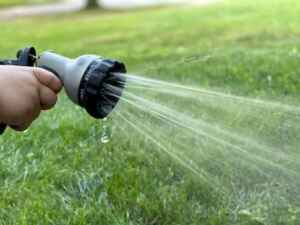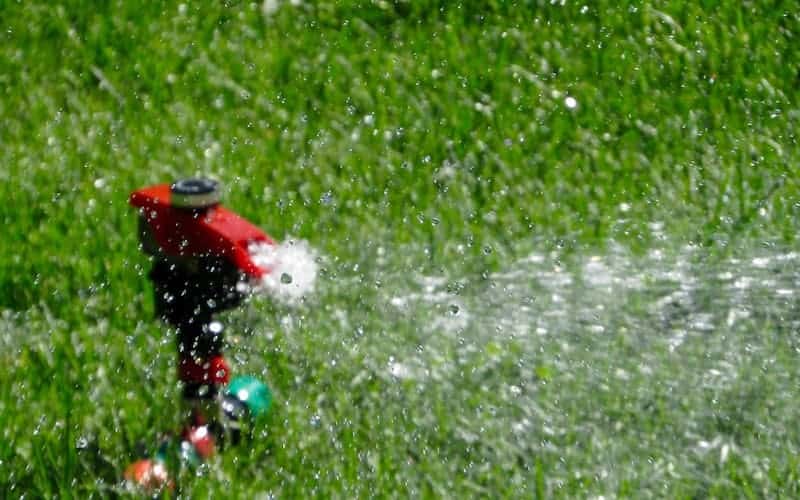How Long Should You Be Watering Your Grass?
How long you are watering can have a huge impact on how green and healthy your lawn appears and grows. The longer you water, the more it soaks into the soil and replenishes moisture. Knowing this, it is crucial to have a time limit when watering your grass. Why would you need a time limit to water your lawn? It’s important to know the average watering times for grass so that it does not become dried out. This also prevents water wastage and oversaturation of your lawn.
So, how long should you water your grass? Good question! The answer depends on several factors like weather conditions (wind, humidity, sun) and plant variety. Watering for about 15-30 minutes will suffice most of the time. Be cautious when watering longer. This can lead to overwatering causing shallow rooting and problems with fungus.
Keep reading to learn more about how to water your grass for the appropriate amount of time.
Timing is Everything
You could water at any time of day, but some tips and tricks will help the watering process go smoothly. For instance, watering in the early morning or evening prevents excess water loss due to evaporation. This also preserves water and exposes less of your yard to direct sunlight, which can cause heat damage. These tips will help you to maximize your time and the amount of water used.
Can You Water Your Grass Too Much?
By watering your lawn you are causing the water table below it to rise. In return, watering excessively can cause drainage issues by saturating your soil. This can lead to fungal growth that prevents air from reaching the roots of the grass which inhibits healthy growth. When watering, consider using an oscillating sprinkler or a handheld hose nozzle for the best results.
Options for Watering More Than Just Grass
 Many people have more than just grass when it comes time to water. You can try some helpful recommendations to promote the health and overall look on your lawn and garden. Watering for 25-30 minutes is a great average time for flowerbeds, trees, and other landscaping. This maximizes the water’s ability to reach the deepest depths of your soil. The same applies to when you are watering hanging baskets, vegetable gardens, and potted plants on a deck.
Many people have more than just grass when it comes time to water. You can try some helpful recommendations to promote the health and overall look on your lawn and garden. Watering for 25-30 minutes is a great average time for flowerbeds, trees, and other landscaping. This maximizes the water’s ability to reach the deepest depths of your soil. The same applies to when you are watering hanging baskets, vegetable gardens, and potted plants on a deck.
Promoting Garden and Floral Health.
You may consider watering vegetables and hanging baskets in the early morning or evening. When watering potted plants and flowers consider the midday hours when sun exposure is minimal. Careful watering practices will help promote healthy, green growth that will be more resistant to drought stress over time.
Expert Tips For Watering Your Grass
- With an automatic watering system, it is important to set the timer correctly. The average time needed for watering is about 15 minutes per zone in your yard, equaling about 1/5th acre. This means if you have four zones, each one needs approximately 6 minutes of watering every watering day.
- When watering by hand, it is best to water for about 20 minutes every other day over the summer. This allows enough time for the water to soak into the ground.
- If you cannot dedicate watering this frequently, then try watering once a week instead. Use normal amounts of watering time as listed above. You can also set up separate days during different times of the season. This will help if you miss one particular day so it will not affect the watering of your lawn.
- Make sure to leave enough time between watering so that you are not watering too frequently. For example, if you water one day, you should wait at least a day before watering again. This will allow all of the watering time to soak into the ground and become more effective for your grass.
What if You Only Have Limited Time to Water?
There are many ways to make watering your lawn easier and less time-consuming. If possible, dedicate small amounts of time every week or two for watering. Your grass will stay green even when it is hotter outside. Just remember not to water too much because this could lead to damaged grass and the possibility of weeds.
Also, keep in mind that requirements for watering vary depending on your region and its climate. Make sure to ask the local watering company or water district for their recommendations.
Watering Times Based on Grass Type and Growth
When watering your lawn or garden, timing is everything! Watering during certain parts of the day or season can drastically affect how healthy your plants are. When you water, it is important that some plants benefit more during the day. Others are better if you water at night. The water needs of lawns and gardens are a function of the plant’s size, type, and time of year. A given area will need more water during drier months than during wetter ones.
Watering Frequencies for Optimizing Grass Growth
- Every other day for very young seedlings up until they are 4 inches tall; then weekly until ready for mowing.
- Shorter grass blades require less frequent watering. Consider weekly during warm months and alternating weeks in the winter.
- If the grass is actively growing, six to eight minutes once per week is sufficient. During the winter months, you can expect to water three to five minutes every other week.
- If the grass is growing, make sure to water it before you mow it! Water once every two weeks during dry months, and once every three to four weeks during winter.
Grass Species and Their Watering Needs
While it is not possible to list every species of grass, there are multiple types you may be familiar with. With this in mind, the types of grass watering needs for each of the following types may vary.
Centipede
This grass is a drought-tolerant variety that you do not need to water often, at least not daily. Centipede can grow in many types of soil types and climates including some more coastal types. In colder weather, this type of grass will go dormant and turn brown. But, do not worry, it will green up again when the warm season returns.
To keep this type healthy, you should make sure there is enough moisture before summer or after winter. This will allow for time to recover from the stress changes bring with them. For centipede types of grass, a general rule is less water equals a healthier lawn. If your yard starts dry you should water it less rather than more.
St. Augustine
This is a warm-season grass that will green up again after winter. But, it does not go dormant in colder weather. These types are very drought tolerant and you do not have to be water them every day. This is especially true if your soil stays moist or you have clay soils.
However, sandy soils can dry out quickly, so St. Augustine grass may need daily watering. This will keep them healthy and looking good during the warmer months when they are growing most actively. When temperatures exceed 100 degrees Fahrenheit this type needs supplemental irrigation. If not, it can begin to suffer damage from heat stress.
Zoysia
Not only does this type turn brown when winter arrives, but it also goes dormant when temperatures exceed 100 degrees. Zoysia types of grass are drought-tolerant types that you may only need to water every three to five days.
In most types of soil, this is not a problem, but sandy soils may require more frequent watering. Zoysia grass will green up again when the cool season returns. Plan to water about once a week during this time for maximum health and appearance.
Bermuda
Bermuda types of grass generally remain green all year long even in cold weather climates. Receiving at least an inch per week when rainfall is scarce, missing one watering day each week is enough. These types need more frequent watering than Zoysia types but less often than Centipede types.
Try mowing Bermuda types a little higher because they tend to develop thatch if left too long between cuts. If you are in an area with warmer summer weather then Bermuda grass is best. This type of grass tends to brown quicker in the winter due to a lack of irrigation or heat.
Perfect Your Watering Technique
 For all grass types, it is important to know where drought is common, as well as areas with water restrictions. An affordable and simple investment is in grass watering timers. This will allow you to water various types of grass more effectively.
For all grass types, it is important to know where drought is common, as well as areas with water restrictions. An affordable and simple investment is in grass watering timers. This will allow you to water various types of grass more effectively.
When you water your lawn, the last thing you want is to waste time and money on frivolous watering sessions. The best way to save yourself from being wasteful is to conserve the amount of time you water for. Your lawn will then have enough water but not too much to drown it in. As I learned more about grasses and watering, I used new techniques to have the best lawn on the block!

